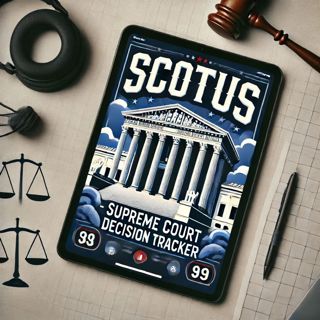
Landmark Supreme Court Decisions and Upcoming Cases Shaping American Law
As we track the latest developments from the US Supreme Court, several significant events and decisions have captured attention in recent days.The Supreme Court has been busy with emergency applications, many of which involve capital punishment cases. For instance, the Court denied an emergency application for a stay of execution in the case of Christopher Collings, despite pending review of similar due process concerns in another case, _Glossip v. Oklahoma_[1].In another notable case, the Court denied an emergency application to stay the execution of Richard Bernard Moore, who argued that his trial was marred by the unconstitutional striking of Black jurors due to their race[1].On the administrative law front, the Court's previous term saw a landmark decision that could have far-reaching implications. The Court ruled that the SEC's use of its own Administrative Law Judges (ALJs) to adjudicate enforcement actions violated the Constitution, specifically the Seventh Amendment right to a jury trial and the non-delegation doctrine. This decision challenges the established practice of using ALJs and limits Congress's ability to delegate legislative power to agencies without clear guidelines[3].Looking ahead to the 2024-25 term, the Supreme Court has added several significant cases to its docket. One of these is _Garland v. VanDerStok_, which involves a nationwide ban upheld by the Fifth Circuit Court of Appeals and will be argued on October 8, 2024. Another key case is _Glossip v. Oklahoma_, which raises questions about the constitutionality of certain execution methods and the concealment of key witness information by prosecutors[4].Additionally, the Court will consider cases such as _Nuclear Regulatory Commission v. Texas_, which addresses the licensing of private companies to store spent nuclear fuel, and _Food and Drug Administration v. Wages and White Lion Investments_, which deals with the marketing of new e-cigarette products[4].These cases and decisions highlight the ongoing and future impact of the Supreme Court on various aspects of American law and society.Thank you for listening to the SCOTUS News Tracker podcast. Don't forget to subscribe for the latest updates and in-depth analysis on the US Supreme Court.This content was created in partnership and with the help of Artificial Intelligence AI
23 Dec 20242min

"Supreme Court Tackles High-Profile Cases: Navigating the 2024-25 Term"
As we track the latest developments from the US Supreme Court, several key cases and decisions have garnered significant attention in recent days.The Supreme Court has been busy with its 2024-25 term, which began on October 7, 2024. One of the high-profile cases scheduled for this term is *Garland v. VanDerStok*, which was argued on October 8. This case involves a challenge to a nationwide ban, with the Biden administration seeking review after the Fifth Circuit Court of Appeals upheld the ban.Another notable case is *Glossip v. Oklahoma*, set for oral arguments on October 9. This case revolves around a death row inmate in Oklahoma who is seeking a new trial due to allegations that prosecutors concealed evidence about the key witness's psychiatric care.The Court is also set to address several other significant issues, including the regulation of "ghost guns" by the federal Bureau of Alcohol, Tobacco, Firearms, and Explosives, and the constitutionality of a Tennessee law prohibiting gender-affirming healthcare for transgender youth.In terms of upcoming arguments, on December 2, the Court will hear *FDA v. Wages and White Lion Investments*, which concerns whether a Circuit Court of Appeals erred in setting aside an FDA order preventing the marketing of new e-cigarette products. Additionally, *United States v. Miller* will be argued on the same day, focusing on whether a bankruptcy trustee can avoid a debtor’s tax payment to the United States under specific bankruptcy laws.On the horizon, *TikTok, Inc. v. Garland* is scheduled for December 18, where the Court will consider whether the Protecting Americans from Foreign Adversary Controlled Applications Act, as applied to TikTok, violates the First Amendment.The Supreme Court has also made headlines recently by declining to hear certain cases, such as a challenge to California’s strict vehicle emissions rules and a case involving Peter Navarro’s fight to keep emails from the first Trump administration.As the term progresses, the Court is expected to tackle a wide range of critical issues, from administrative law and environmental policy to First Amendment rights and criminal justice.Thank you for listening to the SCOTUS News Tracker podcast. Don't forget to subscribe for the latest updates and in-depth analysis on the US Supreme Court.This content was created in partnership and with the help of Artificial Intelligence AI
22 Dec 20242min

Supreme Court's Contentious Rulings Reshape Urban Policies: Tackling Homelessness and Societal Impacts
The U.S. Supreme Court, an institution integral in shaping the legal landscape of the nation, often finds itself at the center of contentious rulings that reverberate through various aspects of society. The court's decisions can influence everything from administrative law to how cities handle social issues such as homelessness.For instance, recent rulings from the Supreme Court have led to significant discussions around urban policies, particularly concerning how cities manage public spaces and homelessness. The City of Las Vegas, following a Supreme Court decision, installed barricades at a homeless encampment, reflecting a growing trend where municipal ordinances are increasingly being used to regulate the presence of homeless populations in public areas. These legislative actions, often in the form of camping bans and other penalties, are designed to address public health and safety concerns but have been criticized for potentially exacerbating the problem of homelessness. Critics argue that such measures do not provide a solution to the underlying issues of homelessness; rather, they simply shift the visibility of the homeless away from public spaces, without offering sustainable aid or housing solutions.Expert opinions suggest that without comprehensive policies aimed at tackling the root causes of homelessness — such as affordable housing, healthcare, and job training — punitive measures will only deepen the crisis. Punitive approaches to homelessness can lead to a vicious cycle where those affected find themselves increasingly marginalized, struggling with legal hurdles that make it harder to obtain employment, housing, or government benefits.Moreover, the role of the Supreme Court in cases of significant historical and social impact can be glimpsed through its past decisions, such as the 1944 ruling which upheld the Executive Order 9066. This order authorized the incarceration of Japanese Americans during World War II, a decision now widely criticized and considered a stark example of judicial sanction of racial discrimination. Even at the time, dissenting justices warned about the dangers of such a precedent, fearing it could lead the country into an "ugly abyss of racism."Understanding these decisions in their historical context offers crucial insights into the evolution of judicial thought and the consequences of legal rulings. As the highest court in the land, the decisions of the Supreme Court not only reflect the prevailing judicial philosophies but also shape the societal and moral contours of American life, demonstrating the enduring impact of law on community dynamics and individual rights. Such rulings underscore the balance the court must maintain between interpreting law and safeguarding the principles of justice and equality.This content was created in partnership and with the help of Artificial Intelligence AI
18 Dec 20242min

Supreme Court Rulings Reshape Law School Admissions, Environmental Policies, and Presidential Powers
Recent activities and decisions by the Supreme Court of the United States exert substantial influence across a range of societal and political sectors. Among these decisions, the impact on law school admissions, environmental policies, and presidential powers continue to draw significant attention and debate.Law school admissions concerning minority enrollment has remained broadly consistent following a relevant Supreme Court decision. The American Bar Association reports that first-year enrollment figures for racial and ethnic minorities have stabilized, though the outcome has varied significantly across different institutions. Some schools experienced considerable fluctuations in minority enrollments, which highlights the variable impact of the Supreme Court's decision across the academic landscape. This trend is indicative of the nuanced and localized nature of how such national-level legal decisions influence educational institutions.The Supreme Court has also been at the center of pivotal decisions regarding environmental policies, particularly pertaining to the National Environmental Policy Act (NEPA). A recent ruling may potentially set a precedent that could challenge key aspects of this significant environmental law. Some justices have demonstrated interest in reassessing the D.C. Circuit ruling that currently stands, suggesting a possible recalibration of how NEPA is applied in projects that influence environmental change. This could have far-reaching consequences for environmental protection and regulation, reflecting the Court's substantial role in shaping the nation's legal framework around environmental issues.Furthermore, discussions among legal scholars like Gillian Metzger and Kate Shaw have highlighted how recent Supreme Court rulings could enhance presidential powers, specifically referencing how these rulings may empower Donald Trump should he secure a second term. The terminology of "a Sword and a Shield" illustrates the dual nature of such legal powers—providing the President both offensive and defensive legal capabilities. These developments underline the significant and continuing influence of the Supreme Court in not only interpreting the law but potentially shaping the governance and administration strategies of future presidencies.In conclusion, the role of the Supreme Court in contemporary American society and governance remains profoundly impactful. As the Court addresses issues from educational equity and environmental regulation to executive power, its decisions reverberate across all corners of public and private sectors, shaping the national discourse and the everyday lives of American citizens.This content was created in partnership and with the help of Artificial Intelligence AI
17 Dec 20242min

"Landmark Supreme Court Rulings Poised to Reshape Construction, Religious, and Environmental Landscapes"
As the calendar year winds down, professionals in the construction and development sectors, along with legal experts and environmental activists, are keeping a close watch on pivotal cases in the U.S. Supreme Court that could influence future industry regulations and freedoms. Here's a closer look at two significant cases currently before the Supreme Court that might reshape legal landscapes in religious rights and environmental regulations.Firstly, the Supreme Court's decision to take up a case from the Catholic Charities Bureau of the Diocese of Superior, Wisconsin, highlights ongoing tensions between religious freedom and regulatory mandates. This case involves the religious organization’s quest for an exemption from clauses in legislation that they argue infringe on their religious beliefs. Scheduled for hearing on December 13, this case will test the boundaries of religious liberties against governmental policies. The outcome could potentially set a precedent affecting how religious organizations engage with state and federal laws, particularly those that could be seen as contradictory to their religious doctrines and practices.Simultaneously, the Supreme Court is deliberating on the environmental and regulatory implications of the proposed Uinta Basin Railway in Utah. This case centers on a contentious proposal to construct a rail line designed to transport waxy crude oil. Proponents argue that the railway is essential for efficient energy transportation, which could bolster economic growth and energy independence. Conversely, environmental groups have raised alarms about the potential ecological impact, emphasizing concerns about disruptions to wildlife habitats and increased risk of pollution.The Supreme Court's ruling on this matter will be crucial for future federal environmental regulations. It's particularly significant as it may clarify the extent to which federal government can regulate or promote industrial projects that arguably conflict with environmental conservation efforts. The decision could influence not just future infrastructure projects similar to the Uinta Basin Railway but also how environmental assessments and approvals are handled across the U.S.These cases underscore a broader trend of fraught interactions between development interests and environmental and ethical considerations. As such, the decisions made by the Supreme Court in these cases will likely reverberate through multiple sectors, shaping future debates and policies regarding the balance between growth, religious freedoms, and conservation efforts. Each ruling will potentially serve as a legal benchmark for similar conflicts that might arise in the future, guiding how laws are interpreted and applied across various states and industries.This content was created in partnership and with the help of Artificial Intelligence AI
16 Dec 20242min

Australia's Supreme Court Orders Museum to Admit All Visitors, Overturning Gender-Exclusive Policy
In a landmark decision by Australia's Supreme Court, a prominent museum was ordered to stop barring male visitors from its "Ladies Lounge" art installation. This ruling overturned previous policies that restricted access based solely on gender, emphasizing inclusivity and equal rights under Australian law. The museum will now permit entry to all visitors, regardless of gender, to view its historically women-only exhibit.In another incident from Pakistan, the Supreme Court made headlines with significant updates in a military court case. Although specific case details were not disclosed, the decision underscores the pivotal role of the Supreme Court in shaping legal interpretations and ensuring justice in cases involving military tribunal appeals.Meanwhile, in Illinois, the Supreme Court has taken up the case concerning Sonya Massey after the Illinois Appellate Court's involvement. With her father, Wilburn Massey, advocating for a just resolution, the case highlights the complex legal battles families often endure and the crucial function the Supreme Court serves in adjudicating sensitive appeals. These cases reflect the diverse spectrum of issues handled by supreme courts, ranging from social justice to military legality, reinforcing their vital place in legal systems worldwide.This content was created in partnership and with the help of Artificial Intelligence AI
13 Dec 20241min

Supreme Court's Rulings Reshape Gun Rights, Corporate Litigation, and Electoral Outcomes
The Supreme Court of the United States, often abbreviated as SCOTUS, plays a critical role in shaping the legal landscape of the country through its decisions on various contentious issues. Among these decisions, those pertaining to gun rights have profound implications across federal courts, illustrated vividly by the court's ruling in the Bruen case. This particular decision, according to a compilation by The Trace, has influenced over 1,600 challenges to gun regulations, demonstrating the expansive reach and impact of Supreme Court rulings in redefining federal law.In another instance reflecting the court's decisive role in business and technology sectors, the Supreme Court concluded its review concerning a Ninth Circuit decision that revived a securities fraud lawsuit against Nvidia, a major software company. This outcome underscores the Supreme Court's pivotal role in determining the trajectory of significant corporate litigation, influencing investor relations and regulatory practices within the technology industry.Historically, the Supreme Court's decisions have also determined political outcomes, a notable example being the Bush v. Gore decision on December 12, 2000. This ruling effectively decided the presidential election by halting a recount in Florida, showcasing the court's crucial involvement in resolving disputed electoral outcomes. This decision not only shaped the governance of the United States but also set a precedent in electoral jurisprudence.Each of these cases highlights how the Supreme Court's decisions reverberate through various facets of American life, from individual rights to corporate conduct and national politics, cementing its role as a fundamental pillar of the U.S. constitutional system.This content was created in partnership and with the help of Artificial Intelligence AI
12 Dec 20241min

Supreme Court to Decide Fate of Uinta Basin Railway Project, Impacting Environmental Regulations in the U.S.
In a move that holds significant implications for environmental law in the United States, the Supreme Court is set to deliberate a contentious case involving the proposed Uinta Basin Railway in Utah. This case, known officially as Seven County Infrastructure Coalition, et al. v. Eagle County, Colorado et al., centers around a blocked railway project intended to facilitate more robust transport of crude oil from eastern Utah's oil-producing regions to broader markets. The project, strongly backed by industry and some regional stakeholders, has faced stern opposition from environmental groups and other opponents due to its potential environmental impacts.The heart of the dispute is the application and interpretation of environmental legislation, specifically the National Environmental Policy Act (NEPA), enacted over 50 years ago. NEPA requires federal agencies to assess the environmental effects of their proposed actions prior to making decisions. Two decades have passed since the Supreme Court has taken a hard look at NEPA, making the current proceedings a landmark moment.Supporters of the railway argue that the project is essential for economic growth and energy independence, suggesting that NEPA's regulatory requirements are excessively stringent and stifle infrastructure development. They are pressing the Court to reconsider and potentially narrow the scope of NEPA, which could fundamentally reduce the regulatory hurdles for similar projects across the nation.On the other side, environmental advocates assert that weakening NEPA could lead to insufficient oversight and inadequate environmental protection, posing greater risks to ecosystems and public health. They contend that comprehensive environmental reviews are vital to ensure sustainable development and to safeguard against long-term ecological damage.The Supreme Court's decision in this case could have far-reaching consequences for environmental policy and economic development in the United States. A ruling that narrows the scope of NEPA might expedite various projects but at the potential cost of environmental integrity. Conversely, a decision that upholds the robust application of NEPA could reinforce the statute's role as a cornerstone of environmental oversight but continue the concerns of project delays and increased costs for infrastructure development.Legal analysts and environmentalists alike are closely watching the proceedings, which commenced with oral arguments. The outcome will likely resonate beyond this single project, influencing how environmental laws are applied to a wide range of federal actions in the future. Not only is the direct impact on the Uinta Basin Railway at play, but the broader implications for environmental protection and regulatory balance in the U.S. are also at stake.This content was created in partnership and with the help of Artificial Intelligence AI
10 Dec 20242min





















